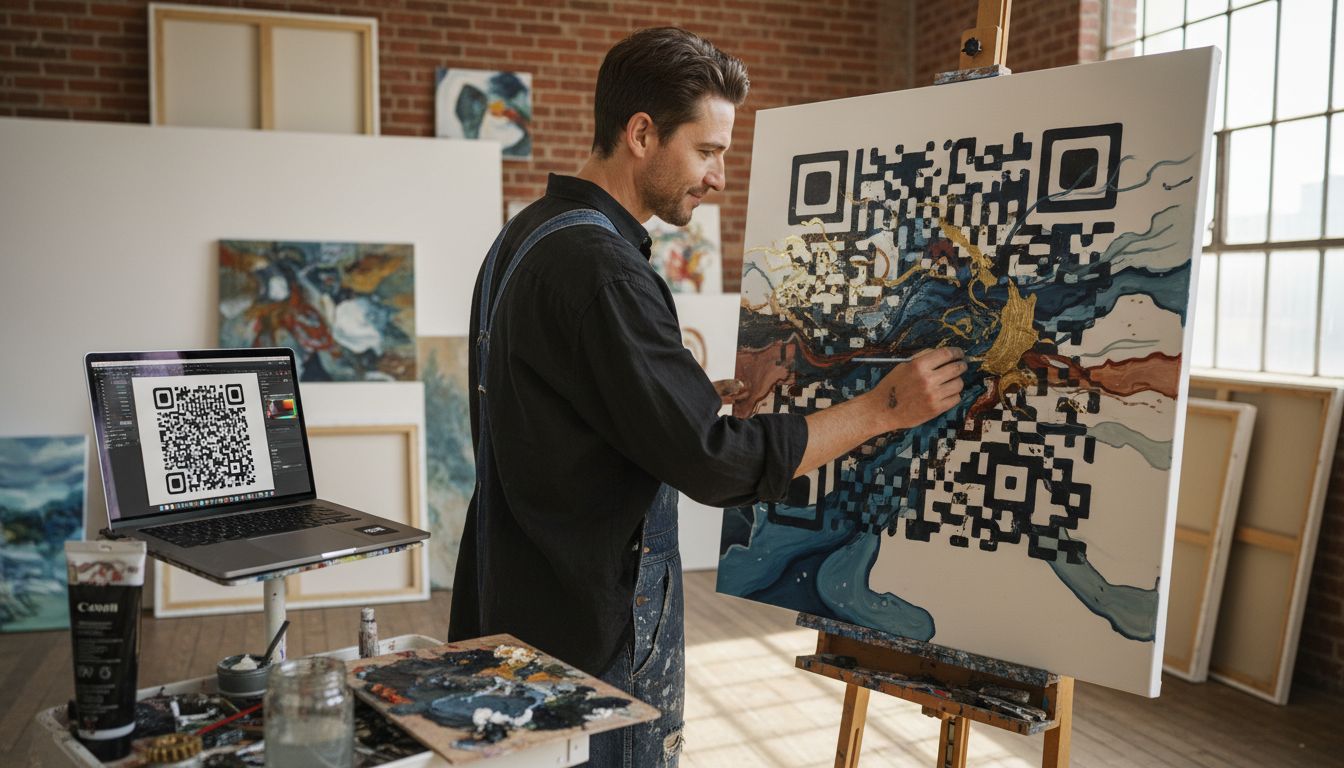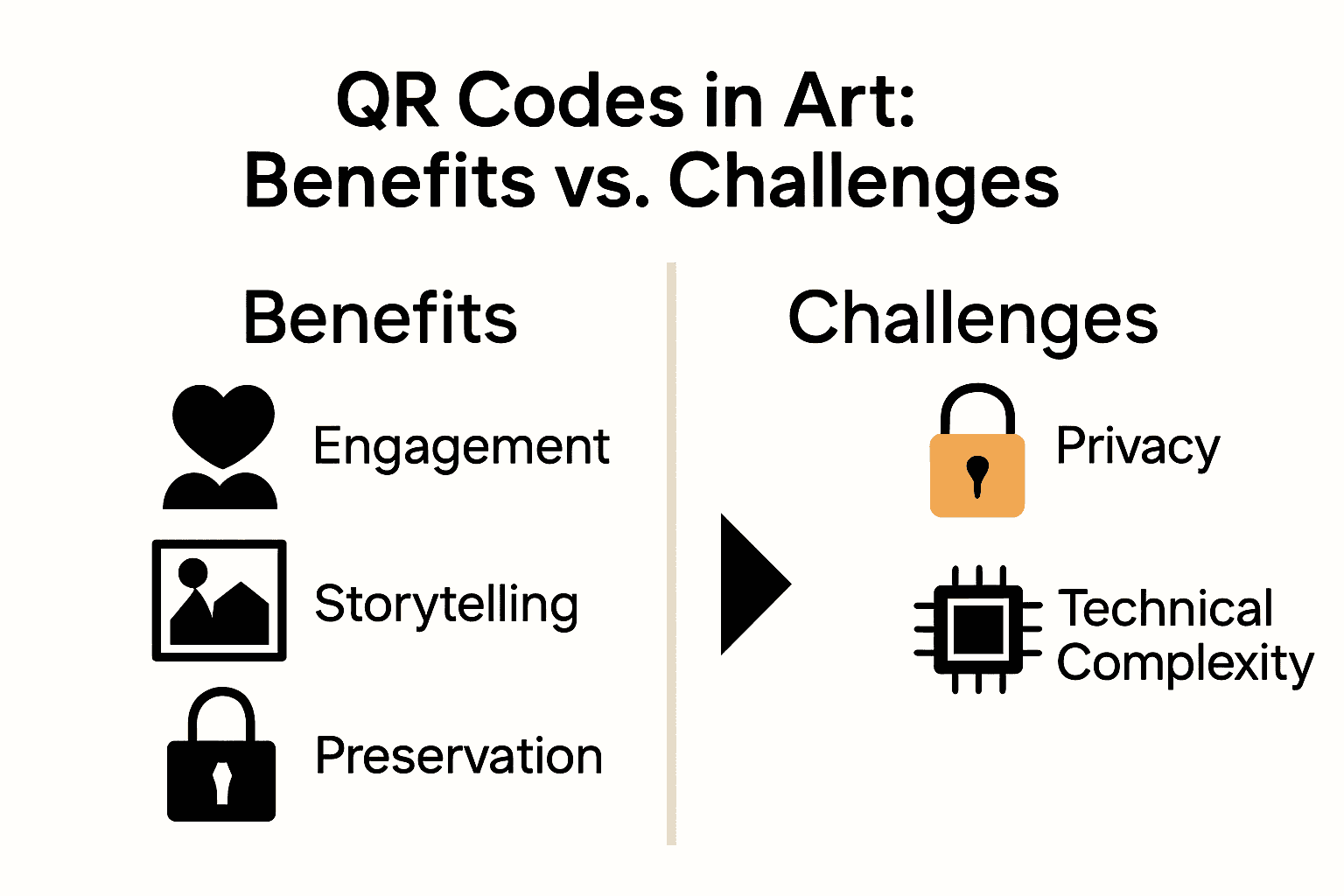Role of QR Codes in Art: Complete Guide
Over one billion QR codes are scanned worldwide every year, turning simple images into gateways for digital discovery. As artists seek new ways to connect with audiences, these codes offer far more than just quick access to websites. They unlock rich layers of interaction, linking physical artworks to videos, stories, and immersive experiences. This evolution is changing how creators share their vision and inviting viewers to explore art in entirely new ways.
Table of Contents
- Defining QR Codes and Their Art Applications
- Types of QR Code Uses in Art Projects
- How QR Codes Integrate With Artistic Works
- Benefits and Challenges for Artists and Audiences
- Security, Privacy, and Preservation Considerations
Key Takeaways
| Point | Details |
|---|---|
| Integration of QR Codes in Art | Artists are increasingly integrating QR codes into their works to enhance audience engagement and provide deeper narratives. |
| Multimedia Storytelling | QR codes facilitate the embedding of digital content in physical art, allowing for rich, interactive experiences. |
| Accessibility and Preservation | These codes enable multilingual access to information and assist in the digital preservation of artworks. |
| Security and Privacy Concerns | Artists must address data protection and privacy when incorporating QR codes to safeguard sensitive information. |
Defining QR Codes and Their Art Applications
QR codes, or Quick Response codes, represent fascinating two-dimensional barcodes that transform how artists communicate and engage audiences. According to Wikipedia, these digital markers can store complex information like URLs, text, and multimedia content, which can be instantly accessed through smartphone scanning.
In the art world, QR codes have emerged as powerful interactive tools that bridge physical artwork with digital experiences. Research from academic journals demonstrates their incredible potential in museum settings, where they can provide comprehensive guides and contextual information about exhibits. Artists now leverage these codes to:
- Offer behind-the-scenes artist statements
- Link to supplementary digital content
- Create multilayered interactive art installations
- Enable viewers to access historical or contextual information
The versatility of QR codes allows artists to experiment with innovative storytelling techniques. By embedding these codes within paintings, sculptures, or mixed media works, creators can transform passive viewing experiences into dynamic, multimedia journeys. Learn more about integrating QR codes into art projects, where technology meets creative expression in unexpected and compelling ways.
Types of QR Code Uses in Art Projects
QR codes have revolutionized artistic expression by providing innovative ways to connect physical artworks with digital experiences. Between Page and Screen exemplifies this potential, demonstrating how artists can create immersive multimedia projects that blend traditional media with digital interactivity.
Artists explore multiple creative applications of QR codes across different artistic domains:
- Interactive Exhibitions: Museums and galleries use QR codes to provide deeper context about artworks
- Multimedia Storytelling: Embedding digital narratives within physical art installations
- Artist Portfolio Enhancement: Linking personal websites, artist statements, and documentation
- Augmented Reality Experiences: Creating layered, interactive art pieces
One particularly fascinating application comes from QRpedia, a system that demonstrates how QR codes can deliver multilingual information about exhibits. This technology allows artists to transcend language barriers, making art more accessible to diverse global audiences. Explore comprehensive guides on information access via QR codes to understand how these digital markers are transforming artistic communication and audience engagement.
How QR Codes Integrate With Artistic Works
Artists are pushing the boundaries of digital creativity by seamlessly integrating QR codes into their artistic practice. Recent research from arXiv highlights the DiffQRCoder project, which introduces innovative methods for generating aesthetic QR codes that maintain critical scanning functionality while allowing unprecedented artistic expression.
The integration techniques for QR codes in artistic works are diverse and compelling:
- Embedded Narratives: QR codes hidden within artwork that reveal additional layers of meaning
- Interactive Installations: Codes that trigger multimedia experiences when scanned
- Digital Preservation: Linking physical artworks to comprehensive documentation
- Audience Engagement: Creating dynamic interactions between viewers and art pieces
Text2QR research further demonstrates how artists can now customize QR code aesthetics without compromising their technical integrity. This breakthrough allows creators to transform these digital markers from mere functional tools into genuine artistic elements.
 Learn more about how QR codes store information to understand the intricate ways these digital gateways can enhance artistic expression and audience interaction.
Learn more about how QR codes store information to understand the intricate ways these digital gateways can enhance artistic expression and audience interaction.
Benefits and Challenges for Artists and Audiences
QR codes present a complex landscape of opportunities and technical challenges for artists and audiences alike. Research from arXiv highlights the critical balance between aesthetic design and functional integrity that artists must navigate when incorporating these digital markers into their creative works.
Key benefits for artists and audiences include:
- Enhanced Storytelling: Providing deeper context and multimedia experiences
- Increased Audience Engagement: Creating interactive artwork experiences
- Digital Preservation: Documenting and archiving artistic processes
- Accessibility: Enabling multilingual and multimedia information sharing
ART-UP research introduces innovative methods for generating scanning-robust aesthetic QR codes, addressing the primary challenge of maintaining visual appeal without compromising technical functionality. Artists must carefully consider design elements to ensure that their QR code integrations remain both visually compelling and technically reliable.
 Explore our guide on labeling art with QR codes to understand the nuanced approach required for successful artistic integration of these digital technologies.
Explore our guide on labeling art with QR codes to understand the nuanced approach required for successful artistic integration of these digital technologies.
Security, Privacy, and Preservation Considerations
Digital security becomes paramount when artists integrate QR codes into their creative works. Research from MDPI introduces advanced techniques for securing QR code data, demonstrating the critical importance of protecting sensitive information shared through these digital markers.
Key privacy and security considerations for artists include:
- Data Encryption: Protecting sensitive artistic documentation
- Access Control: Limiting who can view embedded digital content
- Metadata Protection: Preventing unauthorized information extraction
- Long-Term Digital Preservation: Ensuring artwork documentation remains intact
Confidential QR code research further highlights innovative approaches to enhancing information privacy, addressing growing concerns about unauthorized data access. Artists must carefully balance the desire for openness with the need to protect their intellectual property and audience data. Discover our comprehensive guide on information access via QR codes to navigate these complex digital security challenges while maintaining the creative potential of QR code technologies.
Bring Your Artistic Vision to Life with QR Codes and Smack Tags
The article highlights the power of QR codes to transform art into interactive experiences while preserving stories behind each creation. If you want to seamlessly blend physical artworks with digital narratives or enable viewers to access rich multimedia content behind your pieces, Smack Tags provides the perfect solution. Our durable, fade-resistant QR code labels are ideal for artists seeking to enhance audience engagement, archive artistic processes, and share behind-the-scenes stories — all without the need for complicated apps.

Discover how easy it is to label your artwork and link digital content with our versatile tags. Whether you want to showcase videos, add artist statements, or create immersive exhibits, explore our Creative – Smack Tags collection and start preserving your art’s legacy today. Visit Smack Tags now to get your hands on your first set of tags and turn your art into an unforgettable interactive experience.
Frequently Asked Questions
What are QR codes and how are they used in art?
QR codes are two-dimensional barcodes that store information like URLs, text, and multimedia content. In art, they connect physical artworks to digital experiences, providing additional context and engagement for the audience.
How can artists effectively integrate QR codes into their artworks?
Artists can integrate QR codes by embedding them within their pieces, linking to digital narratives, creating interactive installations, or providing access to more information about their work, enhancing the viewer’s experience.
What are the benefits of using QR codes in artistic projects?
The benefits of using QR codes include enhanced storytelling, increased audience engagement, digital preservation of artistic works, and improved accessibility through multilingual content.
What security concerns should artists consider when using QR codes?
Artists should consider data encryption to protect sensitive information, access control to limit viewer access, and long-term digital preservation to ensure the integrity of their artworks and associated data.
